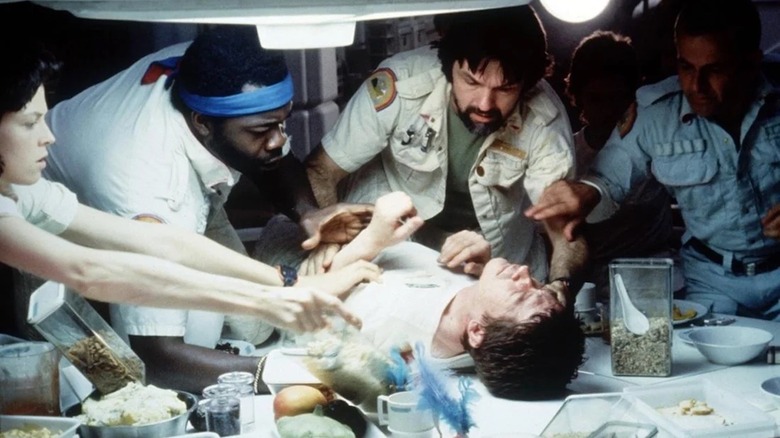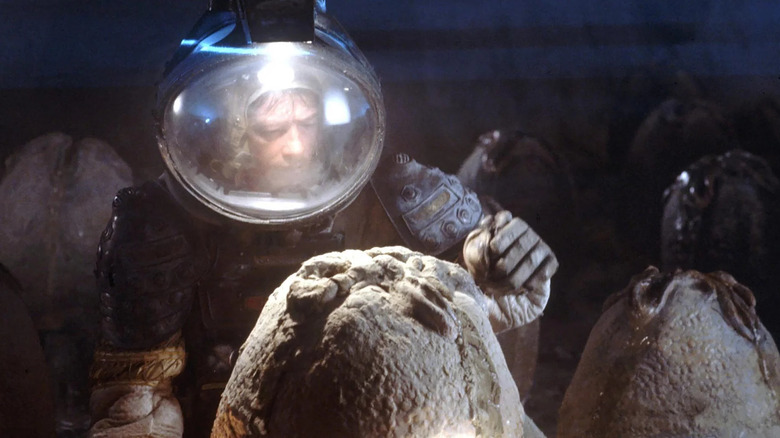John Hurt Didn't Have Much Fun While He Was Filming Alien
The set for Ridley Scott's 1979 film "Alien" was built differently from most sci-fi sets at the time. Looking over the cinematic and TV history of spacecraft interiors, one might find a set built for the bridge or command center, another for engineering or the engine room, perhaps an observation lounge, and maybe a few sleeping quarters. In the sci-fi films and TV shows wherein characters had to walk down hallways or corridors, filmmakers would often save space and time by filming them in the same corridor from several angles. Clever editing can make a 20-foot hallway look like it's several hundred feet.
"Alien," in contrast, built a much more elaborate set. Constructed of old electronics and plane parts, the corridors of the mining craft Nostromo all interconnected, allowing for long, contemplative shots. This was in addition to the usual bridge/engineering/quarters sets. Also the large, elaborate alien space craft designed by Swiss surrealist H.R. Giger.
The goal of all this was, presumably, to make the Nostromo look lived-in. Scott also dressed his actors in everyday clothes — mostly white t-shirts and slacks — eschewing "sci-fi" costumes or Starfleet uniforms. He then had them hang out very casually in smoky rooms, bantering like, well, blue-collar workers. Which they were. The often-used spaceship aesthetic and the timeclock-bound attitudes of the main characters made "Alien" quietly revolutionary in the genre.
In 2009, the late great John Hurt — who played the character Kane — conducted an interview with Rotten Tomatoes, and he revealed that filming under such conditions was physically unpleasant. Indeed, with sci-fi, he said that there is too much going on for much to be fun.
An awful lot of hanging around
Actor John Hurt (who passed away in 2017) had a long and established career prior to "Alien," and continued to work in film and on TV up until his death. He played many, many different types of characters, and worked across all genres, from tiny, soulful dramas to broad, action-packed blockbusters. He was nominated for two Academy Awards for "Midnight Express" in 1978 and for "The Elephant Man" in 1980. In working across genres, Hurt acknowledged that science fiction films, perhaps because of their slavish attention to spaceship details, tend to be a slower-moving machine than other types of dramas.
Hurt talked to Rotten Tomatoes about what he remembered most about working on "Alien," and Hurt seems to recall two elements with utmost clarity: the smoky air and the overwhelming amount of down time. There seemed to be a lot of "hurry up and wait" going on with Scott's film. In Hurt's words:
"I do have fond memories, but I also have a lot of not so fond memories. There's an awful lot of hanging around when you're doing science fiction. Going down and waiting for them to set up, being told to go back to your dressing room while they change the track and the lighting and so on. And you come back four hours later and you're told the same thing. That big stage at Shepperton was just thick with created smoke. It makes me cough just to think about it. I was thrilled to be involved with it, particularly given its legacy. It just wasn't an awful lot of fun to do!
A fun piece of trivia: Hurt also designed a Paddington Bear statue that was placed outside the British Museum to tie in with the release of the first Paddington film.

